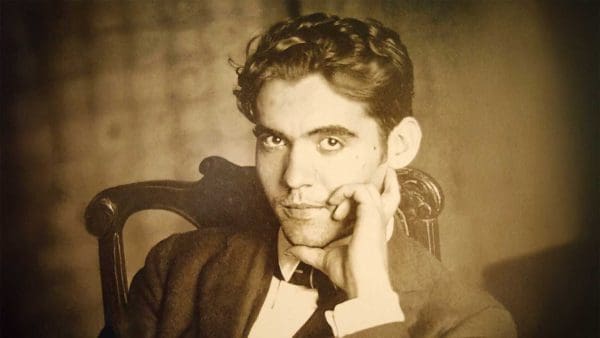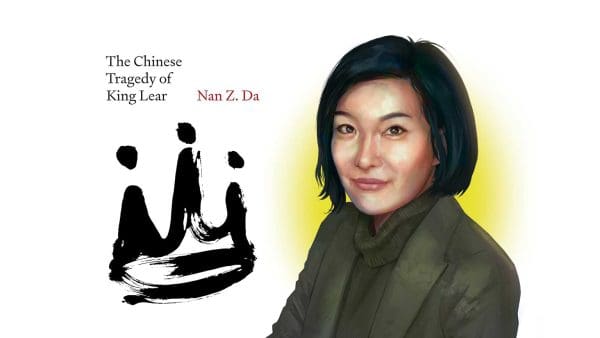Here is how John Irwin would like you to make acquaintance with the greatest poem you’ve never read: find a quiet room by yourself and have a seat in a comfortable chair. Now open a bound volume of the modernist epic The Bridge, and read aloud, starting at the first stanza. Read this:
How many dawns, chill from his rippling rest
The seagull’s wings shall dip and pivot him,
Shedding white rings of tumult, building high
Over the chained bay waters Liberty—
You have now dipped a toe into the poem that marked the culmination of American poet Hart Crane’s brief (1899–1932) and tumultuous life. Irwin—who is the Decker Professor in the Humanities in the Writing Seminars, and has a joint appointment in English—will tell you The Bridge is the best 20th-century long poem in English. It was the subject of his doctoral dissertation at Rice University in 1970. But Irwin’s fully evolved thoughts on the matter are only now reaching publication. In his new book, Hart Crane’s Poetry (Johns Hopkins University Press), Irwin declares at the outset his intent to demonstrate that in form, beauty, daring, and sheer artistic achievement The Bridge outshines other contemporary long works in English (including even T.S. Eliot’s epoch-defining masterpiece The Wasteland) “not by a little, but by a lot.”
It’s a tall order, this, especially since at its publication in 1930 the poem was damningly pegged a “splendid failure” and has held that association ever since; Irwin candidly calls Crane “unarguably the most difficult modern poet in English” and tells how his first take at making the argument for the poem’s supremacy was in the hands of a publisher when he decided to recall the manuscript and work on it some more. That was 40 years ago.
Spend time with John Irwin and two things quickly become evident: He is passionate about words—their power, their beauty and their mystery; and the life of a scholar/poet/literary critic appears to suit him. He will cogitate why his students seem to easily take to Wallace Stevens, eventually offering, “You know, Stevens is jauntily cultured,” and follow it with the Irwin laugh—robust, full-throated, the natural product of a man who revels in observing the peccadilloes of students and all the rest of humanity. Even after four decades of teaching, Irwin still brims with new poetry, new ideas, fresh insights. You see it in his eyes, magnified in the oversized lenses of his glasses that—with his Sigmund Freud-ish manicured gray beard—define his face. It is this love of language and the passion for story that animate his conversation and have made him a popular teacher and role model for generations of students.
The life of language may have been born in his blood. Growing up one of two boys in Houston, Irwin and his brother both took to book learning. His brother is a Catholic priest who taught ancient Hebrew and Ugaritic at St. Michael’s College of the University of Toronto for most of his career, then became dean of the School of Theology and eventually president of Assumption University in Windsor, Ontario. Maybe it’s the genetic predisposition to words that runs in the family—or perhaps years spent teaching in the classroom—that has convinced Irwin that poetry, and poetic ability, is in some profound way innate. “If you want to know if someone is likely to be interested in poetry you should ask them if, when they were very little, they loved to make nonsense sounds or make up words. That’s the best indicator if somebody cares about poetry,” he observes. Irwin publishes his own poetry under the name John Bricuth, preferring to keep his literary and scholarly criticism separate and distinct from his original compositions, which in recent years have tended to run to long verse dramas. In poetry he claims Alexander Pope as role model and inspiration but observes that “the problem with satires today is that everything satirizes itself.” The absurdity of the venture elicits a great Irwin laugh. “You invent wild things and then reality comes up and invents something wilder.”
When Irwin first arrived at Johns Hopkins as an assistant professor in the Department of English in 1970, among his duties was teaching a course in introductory Anglo-Saxon. From that experience he adopted his poetic nom de plume, Bricuth, coming from the root word bric, a bridge. He has published three books of poetry with a fourth, Pure Products of America, Inc.—a verse drama charting an encounter between a country radio talk show host named Charlie Printwhistle and a televangelist known as Big Bubba—planned for next year. In addition to his poetry, Irwin has published widely in the field of literary criticism, including books on Faulkner, symbology in 19th-century American literature, and books on both the analytic and the hard-boiled detective story.
One class Irwin has taught nearly every year since moving to become chair of the Writing Seminars program in 1977 (a position he held until 1996) has been Readings in Poetry: Eliot, Crane, and Stevens, an examination of the poetry of T.S. Eliot, Hart Crane, and Wallace Stevens in the context of the modernist movement in the verbal and visual arts. His critical expertise in modern and American literature has hardly limited his pedagogy however, and over the years in addition to elementary Anglo-Saxon, he has taught such courses as 14th-century English Alliterative Poetry, Studies in Medieval Literature, and even the intriguingly titled Nietzsche, Heidegger, Crane, and Stevens. Yet all the while he has been teaching and talking and thinking about The Bridge—not only as a great though misunderstood poem but more importantly as the key to understanding Hart Crane’s poetry and his significance in 20th-century American letters. “I picked up the Hart Crane book four or five times over 40 years, but each time I would get started something would come up,” he recalls. When he was finishing his third book of poetry he took it up again, but this time with an added incentive: “My wife said to me, ‘You’ve worked on this so long, you simply have to get it done.’ And then we went to visit [family friends] Harold Bloom and his wife in New Haven and Harold said to me, ‘You’ve worked on this so long, you simply have to get it done.’” It may be partly in gratitude and equally in relief that Irwin chose to dedicate the book to the two of them.
Perhaps it should not be surprising that a book about Crane’s poetry could take 40 years to write. Crane the poet is notoriously complex—some would say opaque—a writer who employed “logic of metaphor” to pack layer upon layer of meaning into his lines in much the same way that his contemporary T.S. Eliot does in poems like The Waste Land. But Crane goes even further, employing an essentially visual structure to shape and guide The Bridge. “He out-Eliots Eliot” is how Irwin describes it. An important insight he develops in his book is Crane’s close friendship with many of the leading visual artists of the day. It was a time, says Irwin, “when the arts were in competition to see what was most modern, the most avant-garde,” and the visual arts in particular were electrified by new styles and approaches and techniques. Crane’s friends and acquaintances included Alfred Stieglitz, Georgia O’Keeffe, David Siqueiros, and other prominent artists of the early 20th century, and in fact The Bridge had its genesis in a 1923 exhibition organized by Stieglitz that Crane attended in Manhattan, celebrating the 40th anniversary of the opening of the Brooklyn Bridge. It inspired Crane to write the final poem in the cycle, “Atlantis,” and to begin thinking of a longer and larger verse structure capable, he wrote to writer Waldo Frank, of “including all the strands: Columbus, conquest of water, land, Pocahontas, subway, offices. The Bridge, in becoming a ship, a world, a woman, a tremendous harp as it does finally, seems to really have a career.” Over the next seven years Crane worked backward and forward on the verse cycle, most particularly during the summer of 1927, when he sequestered himself at his grandmother’s estate on the Isle of Pines, Cuba, and wrote a large part of the finished poem.
Crane never went to college, but he was deeply read if largely self-taught, precociously writing essays on Nietzsche and Joyce at the age of 19 and avidly reading Ulysses and The Waste Land when they appeared four years later. He came from a family background of wealth, but at the same time of neither urbanity nor sophistication. Irwin makes this point clear in the subtitle of his book, a line from one of Crane’s letters that simultaneously explains and defends his rejection of European poetic modes. “Appollinaire lived in Paris, I live in Cleveland, Ohio,” Crane wrote, misspelling the French poet and playwright’s name in either a careless or perhaps deliberate dismissal. On the cover of Irwin’s book Crane poses with a mogul’s cigar in hand, wearing a businessman’s sober suit and hat and standing next to his father, Clarence, a successful restaurateur and candy maker who invented and held the patent for Life Savers candies. His relationship with his parents was fraught: he fought with his father because he refused to make a career of the family business and later became permanently estranged from his mother who could not accept her son’s self-confessed homosexuality.
Crane’s first slim volume of poems, White Buildings (1926), was rapturously received on publication, coming at a time in America when poets and poetry held a higher distinction in popular culture than either does today. Writing in The New Republic, Waldo Frank declared, “Not since Whitman has so original, so profound and…so important a poetic promise come to the American scene.” But never shy of exalting his own talents, Crane thought he could do something bigger—something to match and excel Whitman. He wanted to write the great American poem. This was at least partly his intent in writing The Bridge, a poem in which a work of architecture—the Brooklyn Bridge—serves as a metaphor of the American experience, potential, and fate. Moving backward and forward in time between the present day and a fanciful pre-Columbian past, the poem embraces and encapsulates the American experience—or at least tries to. This time around, the reception for Crane’s poetry was decidedly less enthusiastic. The critics, including some Crane counted as friends, declared the work “a splendid failure.” Irwin suggests there may have been more than a little ressentiment on the part of others in the rather too abrupt dismissal of an admittedly challenging and complex work. Crane for his part did not help his cause through a personal combination of belligerence, drunkenness, insolvency, and self-absorption that made his friendship for many an outright ordeal. The critical and financial failure of the book no doubt contributed to Crane’s final act of desperation, when he threw himself from a passenger cruise ship in the Gulf of Mexico just before noon on April 27, 1932. His body was never recovered.
Crane’s suicide helped cement the notion that he died a failed poet, but it is the enticing mystery of his verse that wins him the title as true American poet of the Jazz Age, as in this stanza from the poem “The River” in The Bridge:
You will not hear it as the sea; even stone
Is not more hushed by gravity … But slow,
As loth to take more tribute—sliding prone
Like one whose eyes were buried long ago
The River, spreading, flows—and spends your dream.
This is the poem from Crane’s great work that is most often anthologized and is, to some extent, most easily understood. Irwin suggests that reading the words aloud—reading the words of any poem aloud—helps convey the poet’s meaning. “I tell my students what T.S. Eliot said: Don’t worry about whether you understand a poem or not. Read it. And then read it again. And enjoy it. Once you know that you care about it then try to understand some basic things about it.” In 40 years of thinking and reading and writing about the subject John Irwin has come up with far more than just “some basic things” to say about The Bridge, and he takes more than 400 pages doing it. But 400 pages may be just the right length for the first major critical reappraisal of Crane’s work in more than a quarter century. Although The Bridge is Crane’s most dense and challenging work, Irwin convincingly demonstrates its value not only intrinsically as a work unto itself but also as an enlightening point of entry to understanding Crane’s complete poetic oeuvre—from White Buildings through to his last poem, “The Broken Tower.” In the end, Irwin’s book does something remarkable, outlining a path of understanding for even the casual reader of Crane’s poetry while pointing to a journey of exploration that could make a lifetime’s pursuit. “That’s the thing about the poems of Hart Crane,” says Irwin reflecting on his 40 years’ work, “no one reading exhausts it.”




